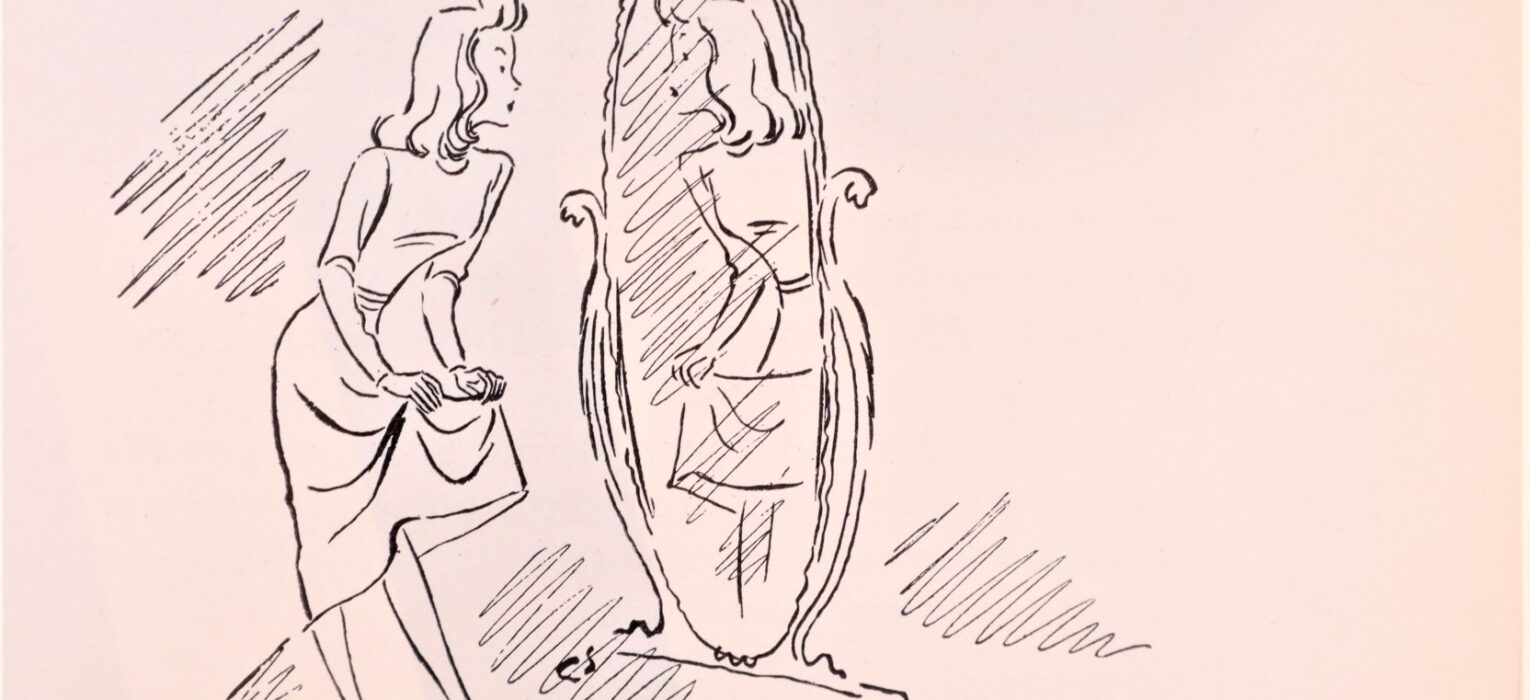The vintage seamstress had several different hem styles from which to choose, depending on the garment being made. From dresses and skirts, coats, jackets, and dainty underwear, she would know which hem stitch was best. This tutorial is a helpful guide for the modern crafter who’s been wondering just how those vintage hems were sewn.
Stitched-Edge Hem

A neat finish for edges which cannot be rolled. Turn the edge and stitch, then turn again and hem invisibly by hand.
Narrow Hem Twice Stitched

Used for edges on cotton frocks and household accessories. Turn raw edges and stitch. Then turn and stitch again.
Decorative Stitched Edge

Pink the edge of your fabric and turn the hem and press. Make as many rows of machine stitching as desired.
Damask Hem

The edges on table linen should be finished with whipped hems. Turn and crease a double hem the full length of you piece. Then fold back the hems as shown. Whip with tiny stitches taking up only one or two threads of the material.
Machine Turned Narrow Hem

By using the hemming foot on the machine, your fabric will be turned twice and stitched in one operation. Guide the material as shown.
Catch-Stitched Hem

Used for hems of coats which are to be lined and for infants’ woolen garments. Working from left to right, catch one thread first in the hem then one in the garment in a zig-zag fashion as shown.
Hem In Circular Godet

Measure hem and baste along turning. Take up fulness at top of hem by tiny pleat at regular intervals. Finish with hemming stitch.
Stitched And Rolled Hem

Nice for lingerie and hand finished edge. Stitch ¼” from edge. Trim to 1/8″. Roll edge a few inches between thumb and forefinger. Catch roll in place with slip-stitching.
Hand-Rolled Hem

This type of hem is especially useful for dainty underwear, handkerchiefs, formal dresses and full bias skirts. Roll edge between thumb and forefinger and catch roll in place with whipping stitches. Do not roll edge more than a few inches ahead of sewing.
Shell Hem

This is a decorative finish used on the edges of collar and cuffs or lingerie. Baste. Use running stitches, then take two stitches over edge as show, at regular intervals.
Hemming a Skirt:
After the length of your garment has been marked, measure the hem allowance with a gauge to see that it is the same width all around. The correct hem-width for each style is indicated in your sewing pattern. If your figure causes the hem allowance to vary, trim it evenly. If, though some chance, you have made your hem allowance too narrow at any point, piece it to the correct width. Turn hem, being careful to line up the seams, and baste near the fold. Study the treatment of wide hems given below and use the type best suited to your fabric. Make your hemming stitches practically invisible on the right side, but do not space them too closely together, and do not pull the thread tight. Sew with a light hand.
Slip-Stitched Hem

For cotton fabrics and firmly woven silk or rayon, the stitched edge hem is recommended. To do this, turn under raw edge and stitch. Then pin and slip-stitch down as shown.
Taped Hem

Turn up about 2½ inches. Baste along turning. Gather top so that hem will lie flat (shrink out gathers in woolen fabrics). Stitch gathered edge to binding, then slipstitch as for plain hem. Use binding also for straight woolen skirts.
Hemming a Pleated Skirt

Clip seam edges to the stitching at the top of the hem. Turn your hem as described in either first or second example above, using the finish best suited to your fabric.
Circular Hem

If your skirt is slightly circular you will find the top of your hem too full to lie flat. Gather the fulness with a running stitch (or by pulling up the under thread if you use the machine) and distribute it evenly. Hem as shown.
Dresses and Skirts, Straight-Cut – For cotton fabrics and firmly woven silks and rayons, the slip stitched hem. For woolens, other bulky fabrics, and easily frayed materials, the taped hem. For sheers, the slip -stitched hem or one of the narrow hems.
Circular Skirts – The slightly gathered circular hem for medium weight fabrics. The decorative stitched hem for some woolens and firm fabrics. For sheers, the narrow edge stitched twice, the stitched and rolled hem, or the hand-rolled hem.
Coats and Jackets – For those to be lined, the catch-stitched hem. For those unlined, the taped hem or slip-stitched hem, depending on weight of fabric.
Infants’ Wear – For sheets and silks, one of the narrow hand finished or a shell hem. On woolens, the catch-stitched hem.
Dainty Underwear – Hand-rolled hem, stitched edge hem, stitched and rolled hem, or shell hem.
For Other Purposes – Choose an appropriate finish from among the variety of hems shown.


